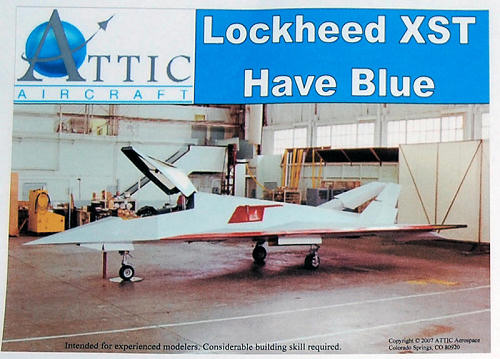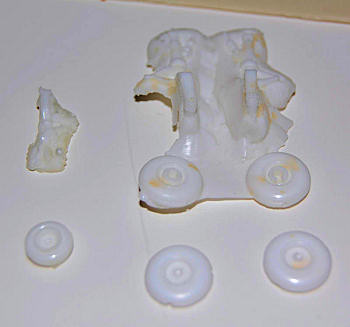
Attic 1/48 Have Blue
| KIT #: | ? |
| PRICE: | $30.00 |
| DECALS: | None provided |
| REVIEWER: | Shawn Payne |
| NOTES: | Resin |

| HISTORY |
The
Lockheed Have Blue was
the code-name for Lockheed's "proof of concept" (i.e. prototype) Stealth Fighter
program that preceded the F-117 Nighthawk production stealth aircraft project.
Designed by Lockheed Advanced Development Programs, now Lockheed Martin Advanced
Development Programs, better known as Skunk Works, Have Blue was developed at
the top-secret Area 51 base near Rachel, Nevada. The Have Blue was the first
fixed-wing aircraft designed from an electrical engineering (rather than an
aerodynamic) perspective. The aircraft's plate-like, faceted shape was designed
to deflect electromagnetic waves, greatly reducing its radar signature.
Two
Have Blue planes were built to test both the flight dynamics and radar returns
of the stealth concept. These prototypes flew at
During testing of the design, the aircraft was flown near (~100 miles away) to
an army radar system, followed at some significant distance by a spotter plane;
over a preplanned flight path. The cover story for the technology was that a
black box in the nose of the aircraft was able to deflect the radar; whereas
obviously the shape of the aircraft did all the real work. Radar only managed to
detect the spotter plane; a soldier placed on the ground directly under the
flight path had to witness the weird looking plane to verify that the flight had
occurred.
The design was inherently unstable about all three axes, control being fly-by-wire adapted from the F-16's single-axis fly-by-wire system. Both aircraft were ultimately lost in the course of testing, the first from a hard landing incident which resulted in the gear being jammed in semi-retracted position and the pilot ultimately being ordered to eject after attempts to persuade the gear to lower and lock proved unsuccessful. The second was the result of an engine fire which severed hydraulic lines, forcing the pilot to eject. The debris from both aircraft was secretly buried somewhere within the Nellis complex.
| THE KIT |
 This kit consists of 15 resin pieces, 8 styrene
plastic gear doors, a vac cano
This kit consists of 15 resin pieces, 8 styrene
plastic gear doors, a vac cano py, and a 6-page instruction booklet and color
reference. The resin castings in my
copy are rough at best and will require lots of clean up.
There are no decals provided and the two prototypes had no markings on
them except for the red ejection seat triangle on both sides of the cockpit.
A quick clean up of the parts and a rough test fit showed lots of
problems areas. First the cockpit
tub takes little modifications to fit into the upper fuselage but the instrument
panel is too large and will not fit under the cowling.
So one will need to be scratch build.
Not a big problem as for this plane it was a simple and basic panel that
only needed to give the pilot basic flight information.
Attic provided an ACES II ejection seat with the kit but I do not believe
that the two Have Blue aircraft were equipped with them.
py, and a 6-page instruction booklet and color
reference. The resin castings in my
copy are rough at best and will require lots of clean up.
There are no decals provided and the two prototypes had no markings on
them except for the red ejection seat triangle on both sides of the cockpit.
A quick clean up of the parts and a rough test fit showed lots of
problems areas. First the cockpit
tub takes little modifications to fit into the upper fuselage but the instrument
panel is too large and will not fit under the cowling.
So one will need to be scratch build.
Not a big problem as for this plane it was a simple and basic panel that
only needed to give the pilot basic flight information.
Attic provided an ACES II ejection seat with the kit but I do not believe
that the two Have Blue aircraft were equipped with them.
The two main fuselage halves are very thick on the outer leading edges of
the wings and the exhaust area will need a lot of attention.
Finally the landing gear in my copy are pretty much a loss. Clean up showed them to be full of holes. But since this aircraft was built with “off the shelf” parts landing gear suitable for this plane should be easily obtained.
| CONCLUSIONS |
All in all this is not a bad kit.
With some work and patience I believe that this model can be made up into a good
representation of the plane that first lead the way to the F-117A.
I do recommend this kit to experienced modelers only.
| REFERENCES |
March 2010
Shawn Payne
Thanks to
 and DLV Company
for the review kit. You can find Italeri kits at your favorite hobby shop
or on-line at
www.testors.com
and DLV Company
for the review kit. You can find Italeri kits at your favorite hobby shop
or on-line at
www.testors.com
If you would like your product reviewed fairly and quickly by a site that has over 300,000 visitors a month, please contact me or see other details in the Note to Contributors.